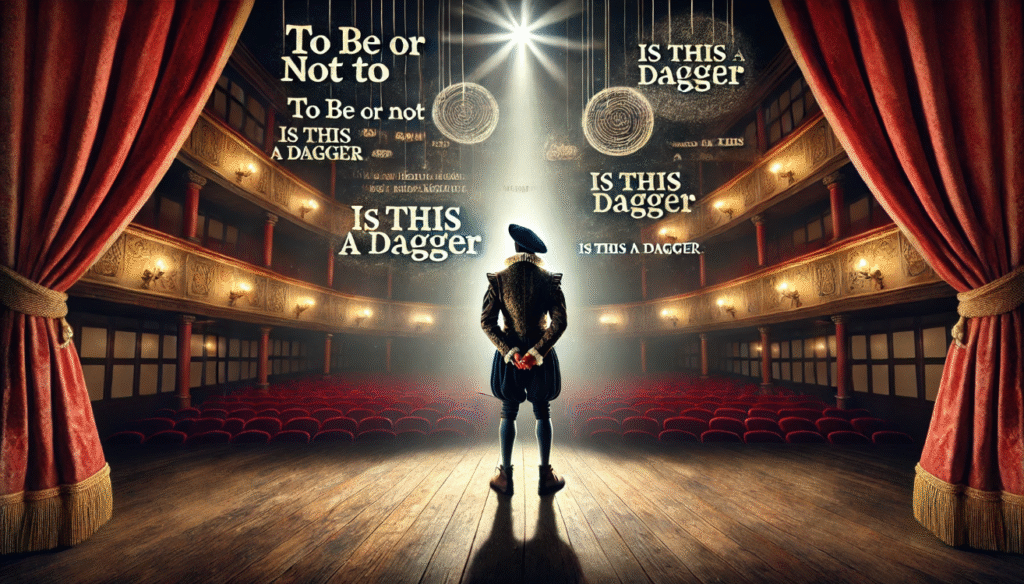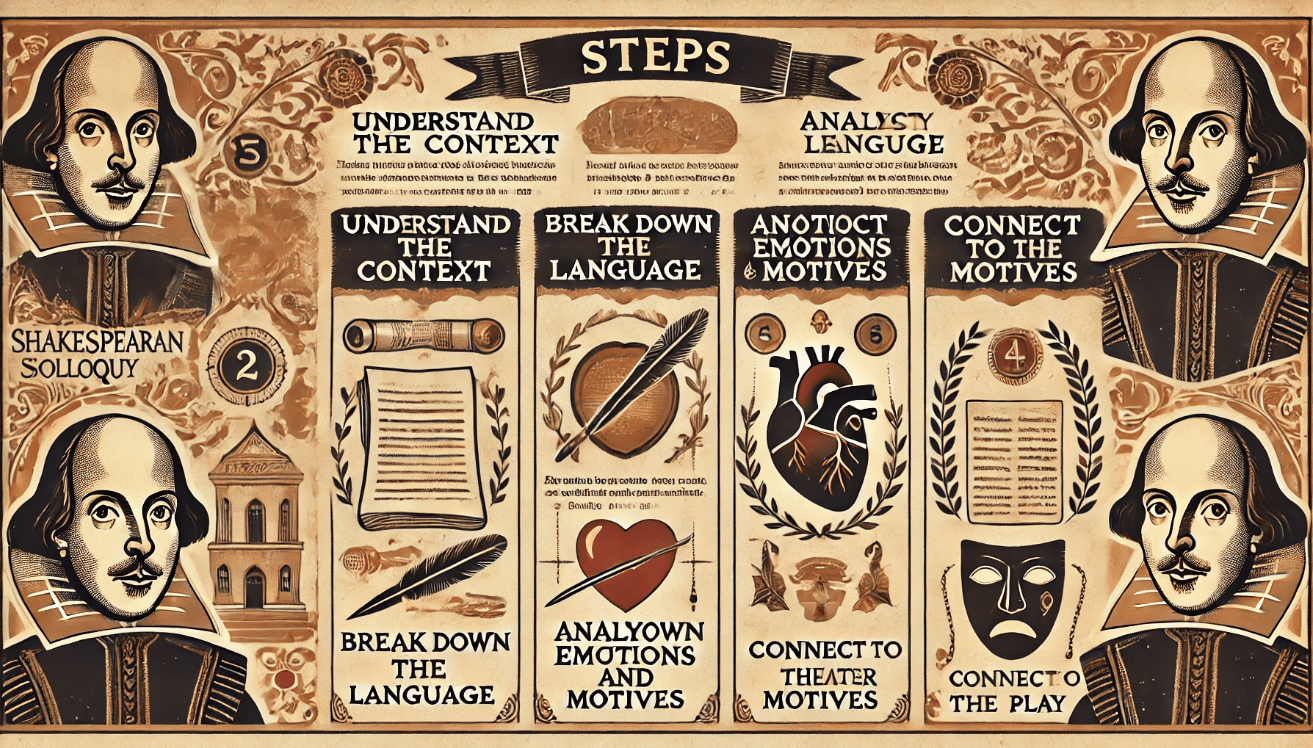
How Shakespeare’s Use of Soliloquies for Dramatic Effect Enhances Character Depth and Audience Engagement
Imagine watching Hamlet and hearing “To be or not to be” spill from the prince’s lips, alone on stage, as his deepest fears unravel. Shakespeare’s use of soliloquies for dramatic effect pulls you into a character’s mind, making you feel their struggles and dreams. For students, theater lovers, or anyone curious about Shakespeare, soliloquies can seem daunting—yet they’re the key to unlocking rich emotions and gripping stories. This article explains how these powerful speeches deepen characters and captivate audiences, offering simple, practical insights to make Shakespeare accessible and exciting. Ready to discover their magic? 😊
Table of Contents
ToggleWhat Are Soliloquies and Why Do They Matter?

Ever wondered what a character is really thinking? A soliloquy is a moment in a play where a character speaks their private thoughts aloud, alone on stage. It’s like a secret window into their mind, revealing emotions, plans, or struggles they can’t share with others. Shakespeare’s use of soliloquies for dramatic effect makes his plays unforgettable, pulling you closer to characters like Hamlet or Lady Macbeth.
Why do they matter? Soliloquies let you see a character’s true self—raw and unfiltered. For example, Hamlet’s “To be or not to be” speech shows his fear of death and indecision, while Macbeth’s guilty ramblings reveal his inner turmoil. This peek into their souls makes the story feel personal and real.
For students, soliloquies are gold for essays—they highlight a character’s motives and emotions. For theatergoers, they create emotional, gripping moments that stick with you. 😊 Want to enjoy Shakespeare more? Pay attention to these speeches—they’re the heart of the drama!
How Soliloquies Enhance Character Depth
Ever wondered what makes Shakespeare’s characters feel so real? His use of soliloquies for dramatic effect lets characters spill their innermost thoughts, revealing layers of complexity that make them unforgettable. These solo speeches turn flat characters into vivid, relatable figures by exposing their struggles, dreams, and flaws.
Take Hamlet’s famous “To be or not to be” soliloquy (Hamlet, Act 3, Scene 1). Alone, he wrestles with life, death, and the fear of action. This raw honesty shows his indecision and philosophical depth, making him more than just a prince—he’s human. Similarly, in Macbeth (Act 2, Scene 1), Macbeth’s soliloquy before murdering Duncan reveals his ambition clashing with guilt, painting him as both villain and victim.
Lady Macbeth’s “Unsex me here” speech (Macbeth, Act 1, Scene 5) is another gem. Her plea to cast aside her femininity for ruthless ambition shows her strength but hints at the guilt that later consumes her. These moments make characters multidimensional, letting you see their hopes and fears.
How Soliloquies Engage Audiences

Ever felt like a character was speaking directly to you? Shakespeare’s use of soliloquies for dramatic effect creates that magic, drawing audiences into the heart of his plays. These solo speeches make you feel like a confidant, sharing a character’s deepest secrets, which sparks emotion and keeps you hooked.
In Othello, Iago’s soliloquies reveal his cunning plans to betray Othello, making you both despise and marvel at his scheming. This direct connection feels like a private conversation, pulling you into the drama. Similarly, Macbeth’s guilt-filled soliloquy before killing Duncan (Macbeth, Act 2, Scene 1) builds suspense—you know what’s coming, and it grips you.
Soliloquies also drive the story forward. When Hamlet ponders revenge (Hamlet, Act 3, Scene 1), his words hint at future conflict, keeping you on edge. In performances, these moments are electric—actors deliver raw emotion, making the theater feel alive.
Practical Applications: How to Analyze Soliloquies

Feeling overwhelmed by Shakespeare’s soliloquies? Don’t worry! Analyzing them is easier than it seems, and it’s a great way to unlock the magic of his plays. Whether you’re a student writing an essay, an actor preparing a role, or a reader wanting to dive deeper, these simple steps will help you break down soliloquies with confidence. Shakespeare’s use of soliloquies for dramatic effect makes them a goldmine for understanding characters and stories.
1: Understand the Context
Start by figuring out what’s happening in the play. Where is the character? What’s driving them? For example, in Hamlet (Act 3, Scene 1), Hamlet’s “To be or not to be” soliloquy comes when he’s grappling with revenge and mortality. Knowing the scene sets the stage for deeper insights.
2: Break Down the Language
Shakespeare’s words can feel tricky, but look for key themes, metaphors, or repeated words. In Macbeth’s soliloquy (Macbeth, Act 2, Scene 1), “dagger” imagery shows his guilt and fear. Underline striking phrases and think about what they reveal about the character’s mind.
3: Analyze Emotions and Motives
Ask: What is the character feeling? Why are they saying this alone? In Romeo and Juliet (Act 2, Scene 2), Romeo’s “But, soft!” speech bursts with love and longing. Pinpointing emotions helps you connect with the character’s heart.
4: Connect to the Play
Consider how the soliloquy shapes the story. Does it reveal a decision, like Lady Macbeth’s ambition in Macbeth (Act 1, Scene 5)? Does it hint at future events? This shows how soliloquies drive the plot.
Beginner-Friendly Tools
- Modern Translations: Use resources like No Fear Shakespeare to clarify tricky lines.
- Watch Performances: Seeing actors deliver soliloquies (try YouTube or live theater) brings emotions to life.
- Discuss with Others: Share ideas with friends or teachers to spark new insights.
Iconic Soliloquies and Their Impact
Want to feel the pulse of Shakespeare’s genius? His iconic soliloquies are where characters come alive, revealing their hearts and driving the story forward. Shakespeare’s use of soliloquies for dramatic effect creates unforgettable moments that stick with you, whether you’re reading or watching a play. Let’s explore three famous examples to see how they deepen characters and grip audiences.

Hamlet’s “To be or not to be” (Hamlet, Act 3, Scene 1)
Hamlet stands alone, wrestling with life, death, and the fear of action. This soliloquy shows his philosophical side and inner turmoil, making him relatable as he questions existence itself. For audiences, it’s a profound moment that sparks reflection on universal fears, drawing you into Hamlet’s mind.
Lady Macbeth’s “Unsex me here” (Macbeth, Act 1, Scene 5)
Lady Macbeth begs to shed her femininity for ruthless ambition, revealing her fierce drive and moral conflict. This speech foreshadows her tragic downfall, building suspense as you sense her choices will unravel. It captivates audiences by showing a woman both powerful and haunted, making her unforgettable.
Romeo’s “But, soft! What light through yonder window breaks?” (Romeo and Juliet, Act 2, Scene 2)
Romeo’s starry-eyed speech about Juliet captures the rush of young love. His words make him a relatable romantic, connecting with anyone who’s felt passion. For audiences, this soliloquy creates a dreamy, emotional high, setting the stage for the lovers’ tragic journey.
Common Challenges and How to Overcome Them
Struggling to connect with Shakespeare’s soliloquies? You’re not alone! Shakespeare’s use of soliloquies for dramatic effect can feel tricky for beginners due to complex language or unfamiliar context. But don’t worry—these common hurdles are easy to overcome with the right approach. Here’s how to tackle them and enjoy the magic of soliloquies with confidence.
Challenge: Complex Language
Shakespeare’s Elizabethan English, with its old words and poetic style, can feel like a foreign language. Lines like Hamlet’s “To be or not to be” may seem dense at first.
Solution: Use modern translations, like No Fear Shakespeare, to read soliloquies alongside plain English versions. Apps or websites with glossaries can also clarify tricky words. Try reading slowly to catch the rhythm—it’s like decoding a song! 😊
Challenge: Missing Context
Without knowing the play’s events, soliloquies can feel confusing. Why is Macbeth talking about a dagger (Macbeth, Act 2, Scene 1)?
Solution: Read a quick plot summary before diving in—SparkNotes or Folger Shakespeare Library are great starting points. Watching a short scene from a film or performance on YouTube can also ground you in the story’s flow.
Challenge: Staying Engaged
Long soliloquies, like Hamlet’s musings on death, can feel overwhelming or hard to follow.
Solution: Break them into smaller chunks. Focus on one idea or emotion at a time, like Romeo’s love for Juliet (Romeo and Juliet, Act 2, Scene 2). Jot down key phrases or discuss them with a friend to keep things lively.
Tips for Students, Actors, and Theatergoers
 Shakespeare’s use of soliloquies for dramatic effect can transform how you experience his plays, whether you’re studying, performing, or watching. These solo speeches are packed with emotion and insight, and with a few practical tips, you can use them to ace essays, deliver powerful performances, or enjoy theater more deeply. Here’s how to make soliloquies work for you, no matter your role! 😊
Shakespeare’s use of soliloquies for dramatic effect can transform how you experience his plays, whether you’re studying, performing, or watching. These solo speeches are packed with emotion and insight, and with a few practical tips, you can use them to ace essays, deliver powerful performances, or enjoy theater more deeply. Here’s how to make soliloquies work for you, no matter your role! 😊
For Students: Ace Your Essays
Soliloquies are perfect for analyzing character motives and themes. In Hamlet (Act 3, Scene 1), Hamlet’s “To be or not to be” reveals his indecision—use it to discuss his inner conflict. Quote key lines, explain their meaning, and tie them to the play’s themes. Pro tip: Start with a clear thesis, like “Hamlet’s soliloquies show his struggle with action,” to organize your essay.
For Actors: Bring Soliloquies to Life

Soliloquies are your chance to shine! Practice delivering them with authentic emotion—pause for effect, vary your tone, and imagine the character’s feelings. For Lady Macbeth’s “Unsex me here” (Macbeth, Act 1, Scene 5), channel her fierce ambition. Watch great performances (try YouTube) to see how pros handle pacing and gestures. Rehearse in front of a mirror to nail the delivery!
For Theatergoers: Feel the Magic

When watching a play, soliloquies are emotional peaks. Notice how Romeo’s “But, soft!” (Romeo and Juliet, Act 2, Scene 2) draws you into his love-struck heart. Pay attention to the actor’s tone and body language—it’s like they’re confiding in you. Before the show, skim a plot summary to catch how soliloquies hint at plot twists, making the story more exciting.
Why Soliloquies Still Matter Today
Shakespeare’s use of soliloquies wasn’t just poetic—it was purposeful. These powerful speeches give the audience a front-row seat to a character’s mind, exposing their fears, hopes, doubts, and dreams. That emotional access creates deeper connection, richer storytelling, and unforgettable drama. 🎭
Whether it’s Hamlet questioning life, Macbeth confronting guilt, or Juliet expressing longing, soliloquies turn private thoughts into public experiences. They deepen character development and engage the audience in ways few dramatic tools can match. For students and scholars, recognizing this technique helps unlock the emotional and structural layers of Shakespeare’s plays.
Frequently Asked Questions (FAQs)
1. What is a soliloquy in Shakespeare’s plays?
A soliloquy is a speech where a character speaks their thoughts out loud, usually while alone on stage. It reveals the character’s inner feelings, motivations, and dilemmas directly to the audience.
2. How do soliloquies enhance character development in Shakespeare’s works?
Soliloquies let the audience hear what the character is really thinking—without filters or outside influence. This adds emotional depth and helps us understand their choices, fears, and growth throughout the play.
3. Why are soliloquies important for audience engagement?
They create a personal connection between the character and the audience by breaking the “fourth wall.” The audience feels like a confidant, which makes the story more intimate, intense, and emotionally powerful.
4. What are some famous examples of Shakespearean soliloquies?
Key examples include Hamlet’s “To be, or not to be,” Macbeth’s “Is this a dagger,” and Juliet’s “Gallop apace.” These speeches show deep emotional conflict and reveal key turning points in the characters’ journeys.
5. How does Shakespeare use soliloquies for dramatic effect?
He uses soliloquies to build suspense, reveal secret intentions, or foreshadow events. The dramatic irony created by sharing a character’s inner world—while other characters remain unaware—keeps the audience engaged.
6. How can students analyze a Shakespearean soliloquy effectively?
Start by understanding the context—when and why it’s spoken. Then break it down into parts: the emotional opening, inner conflict, turning point, and poetic language. Highlight key phrases and how they show the character’s mindset.
7. What’s the difference between a soliloquy and a monologue?
A soliloquy is a private speech meant only for the audience, usually spoken alone. A monologue is a long speech addressed to other characters. Soliloquies reveal personal thoughts, while monologues are more public.
8. How do soliloquies connect to themes in Shakespeare’s plays?
Soliloquies often explore timeless themes like love, guilt, revenge, and ambition. These speeches bring those themes to life by showing how they affect characters on a personal level, helping audiences relate to the story.
